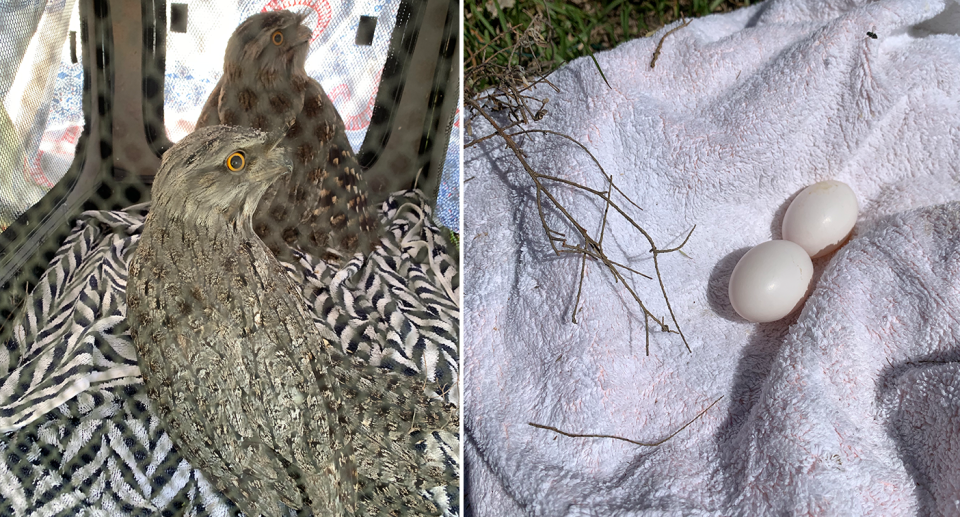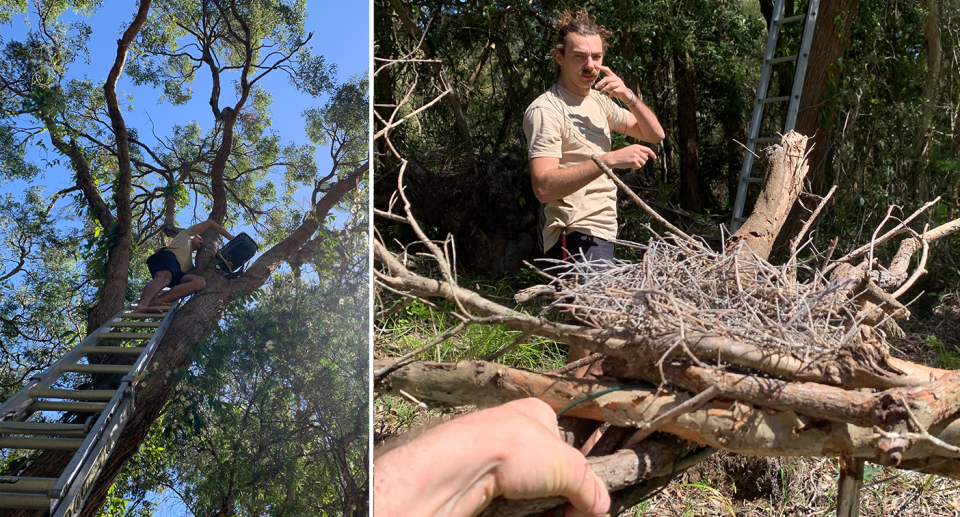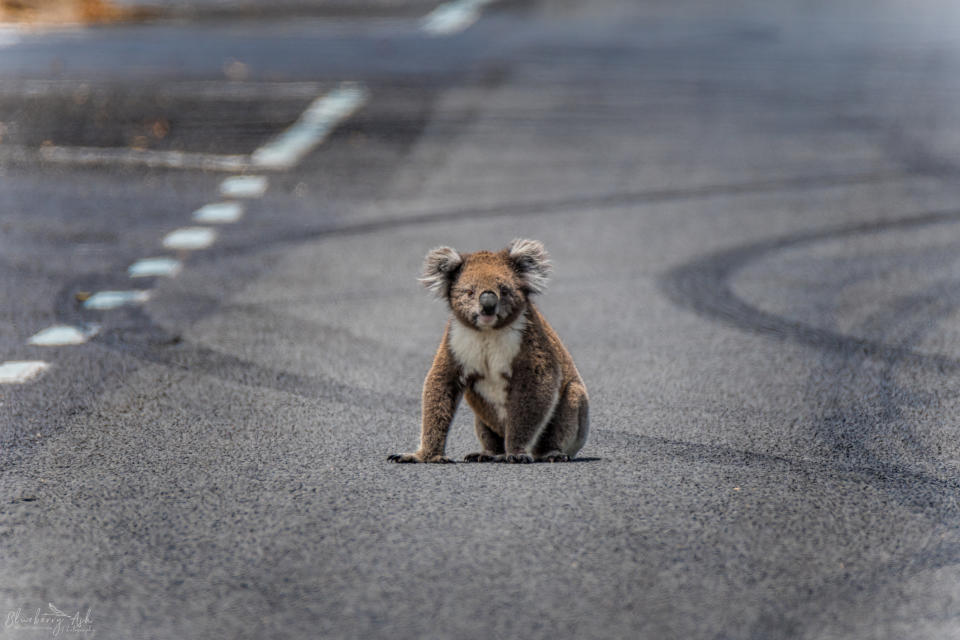Dramatic rescue of 'owl' stranded on wood chipper as last tree on street felled
When a NSW council gave approval to cut down the last tall tree on a suburban street, a pair of tawny frogmouths would lose their nesting site of more than a decade.
Killarney Vale resident Anne Day felt the “owls”, as she referred to the birds, had become “part of the neighbourhood” and she was determined to save them.
Ms Day called the small wildlife organisation I volunteer for and asked for help.
“They’ve been coming to this area for as long as we’ve been here,” she told me over the phone.
“You’d see them sitting on the fence, or up on the tree and they nested last year in the tree and then this year they came again.
“You know, you watch animals from our backyard - sitting outside you can see them.”

Trees come down in Killarney Vale leaving birds stranded
I left my house at 7:30am on Saturday and drove an hour north to Killarney Vale, 60km north of Sydney, to see if I could help.
The work site was already thick with sawdust as two smaller trees had been felled.
Neighbours were leaning over the fence, filming the spectacle with their iPhones.
One lady told me her calls to Central Coast Council had fallen on deaf ears – the permits were issued – there was no plan for the birds.


Arborist John Reynolds from the Tree Monkey expressed a reluctance to remove the big tree at the back of the narrow block.
“It’s difficult, we don’t always want to cut down trees, but obviously we have a duty to the owner of the property if they’ve got to build,” he told me.
“So we try and leave our personal opinions out of it.
“Obviously when there’s habitat, that’s sort of disappointing as well.
“When there’s owls or anything else. It’s a little bit of a conflict of interest because we like the environment – we’re not gung-ho when it comes to clearing, but we also have a job to do which is difficult.”
Tawny frogmouth’s last line of defence – poo
The decision had been made, the tree was being chopped down – despite the nesting birds.
Relocating them was going to be tough as all the other large trees on the street had been cleared years ago.
Like most Australian birds, tawny frogmouths mate for life so it was important to keep the pair together.
After consulting with WIRES and Wildlife ARC, I hatched a plan to try and capture the birds and the eggs, and relocate them to a nearby park.
Despite their appearance, tawny frogmouths are actually unrelated to owls and can do little to protect themselves.
Their main defence is camouflage, and when that doesn’t work they have a last line of defence – excreting a smelly skunk-like poo to help bamboozle their attacker’s senses.
As the young arborist scaled the tree, the female bird tried to create a diversion by flying away, while the male shielded the nest, snapping ineffectively with his beak.
As the arborist grabbed the male and secured him in a soft pet cage, one of the eggs fell and smashed on the ground.
The female was easy to catch – there were no trees for her to escape to.
She rested on the wood chipper, then the eave of a house. I nabbed the confused bird with a net.

She emptied her bowel down my shirt, down my jeans and into my shoe as I put her into the cage with her partner.
Ms Day leaned over the fence, offering me a glass of water.
“It was amazing how they sat there,” she said.
“Right to the bitter end they stayed together.”
I took the water and cleaned myself down.
The bird myth we all believe
I kept the surviving eggs warm in my shirt as I drove the distressed family to a clump of trees at a nearby football oval.
A neighbour, Craig, who had cleared all the trees in his backyard years ago, offered use of his ladder and commandeered a young friend to carry the nest high into another tree.
It’s a myth that parent birds won’t return to their babies if touched by a human - most birds don’t have much of a sense of smell.
In fact each tawny frogmouth chick has a unique cry that its parents recognise and respond to, even after a separation of 10 days.
Eggs are harder to reunite with parents, especially after the nest has been moved, yet it is with their protective mum and dad with who they belonged.
The parent birds were placed on the nest six metres in the air, but still fearful, they flew away to nearby branches.
I left Killarney Vale smelling of tawny poo and hoping that the tawny frogmouths would reunite with their eggs.
Council silent as Environment Minister weighs in
Most Australians would be surprised to know that urban environments like Killarney Vale are actually biodiversity hotspots.
Jess Abrahams from the Australian Conservation Foundation said if Australians want our iconic animals to be part of their future, all levels of government and developers need to reform “avoidable threats” like land clearing.
“Whether it’s the bush along the local creek, woodland, or even old trees with hollows amongst houses, they’re being destroyed to make way for new and bigger houses,” he told me.
“Of course we all need a place to live, but habitat destruction is one of the leading causes of native wildlife disappearing.
“Even though the tawny frogmouth is a fairly common species, the koala was a fairly common species 20 years ago and now it’s vulnerable to extinction.”
Federal Environment Minister Sussan Ley told me the federal government doesn’t have the power to intervene in land clearing matters unless it will impact an area of national significance.
“Local, state and territory governments in Australia have primary responsibility for land management decisions within their jurisdiction, including felling of individual trees in urban areas,” the minister said.
“Urban environments are extremely important in encouraging native wildlife and we are working with communities on a number of levels to support these, including through the Communities Environment Fund.”
Action needed to save Australia’s native habitats

I called Central Coast Council – maybe they could explain why they allowed the tree with nesting birds to be felled. Their answer was brief.
“Council is unable to provide a response in time to meet your deadline,” a spokesperson said on Tuesday morning.
“We will continue to look into it and if more information becomes available, we will let you know.”
Speaking with Ms Day after the relocation, she said she can’t see how a new house next door will be more pleasant than the tree with her birds was.
“You just get used to saying ‘the owls are back’ each year – it’s quite sad to think they’re not there anymore,” she told me.
“A lot of the clearing around here came after the storms - we actually had one in our front yard removed.
“It’s not as green as when we moved here.”
Attempts were made to contact the owner of the block in Killarney Vale.
It remains unclear how best to manage birds and animals when permits are given to demolish their homes.
What is clear is that it is a dilemma that needs to be addressed as urbanisation continues and the natural habitat of precious native species disappears.
Do you have a story tip? Email: newsroomau@yahoonews.com.
You can also follow us on Facebook and Twitter, download the Yahoo News app from the App Store or Google Play and stay up to date with the latest news with Yahoo’s daily newsletter. Sign up here.



